A starfighter, also referred to as a fighter, was a small and maneuverable spacecraft designed for combat in the atmosphere or space. Certain models of bombers, gunships, transports, light freighters, shuttles, trainers, and atmospheric fighters could be considered starfighters as well, and often fulfilled many of the same functions.
Although the term was most commonly applied to starships, it could also include certain low-altitude airspeeders.

Y-wings were considered both bombers and fighters.
Starfighters often had some degree of overlap with other ship classes, as well as a few distinct sub-classes. Bombers were starships designed to carry heavy ordnance payloads, often at the expense of maneuverability and straight-line speed. Interceptors represented a range of starfighters that usually emphasized speed and agility over versatility and firepower, sometimes at the expense of ordnance payloads, life support, or hyperdrive capabilities. Gunships were heavily-armed vehicles designed to deploy ground forces in landing zones created by their heavy weaponry. Their heavy armament often granted them considerable air-to-air or space-to-space combat capabilities, despite being optimized for air-to-ground combat. Certain classes of starfighters could be modified to trainers while still retaining combat capability. These included certain classes of transports, shuttles, and light freighters.
The primary weapon for most starfighters were laser cannons, but these could be supplemented with additional weaponry such as proton torpedo launchers to provide additional firepower. Often these were effective against other starfighters and similar targets, but didn't have the firepower to punch through the defenses of a capital ship as during the Battle of Naboo. However some starfighters like the A/SF-01 B-wing starfighter carried sufficient armaments that they could destroy capital ships on their own. Starfighters could also cause tremendous devastation when working in groups: a squadron of Y-wing bombers were capable of carrying enough ordnance to glass an entire city, bathing the battlefield in blinding white detonations which scrambled enemy sensors.
Many starfighters were equipped with deflector shields to protect them from enemy fire, radiation, and micrometeor impacts. Typically they carried a single deflector shield generator, which could be adjusted to protect specific parts of the starfighter. Some starfighters though, notably the Eta-2 Actis-class light interceptor and TIE/ln space superiority starfighter series, were not equipped with shields, relying instead on their maneuverability and the pilot's skills to avoid these dangers. Other common forms of protection included heavy armor plating and sensor jammers. Starfighters were equipped with warning systems to let them know when an enemy missile was locked on to them, and could also use their laser cannons to shoot these down, even against missiles traveling at incomprehensible speeds, so long as their targeting computer was functional.
Some starfighters were equipped with a hyperdrive, whether integral to the craft itself or by means of external attachment such as a hyperspace transport ring. Because of their small size, most starfighter navigation computers or navicomputers could only carry one or two hyperspace routes which either had to be pre-programmed into the computer or installed via removable datachips (for emergency jumps, navicomputers could also receive coordinates transmitted from friendly ships). This made astromech droids a valuable addition to many starfighters in that they had the storage capacity to carry up to ten hyperspace coordinates.
A starfighter's primary means of propulsion were sublight engines which allowed it to get clear of a planet's atmosphere and gravitation field in a matter of minutes and cross vast distances of realspace. Though small, these sublight drives were capable of accelerating starfighters at thousands of times standard gravity. To protect their pilots from being killed by the G-force generated by sublight drives, starfighters were equipped with acceleration compensators. These compensators were designed to automatically adjust their settings during flight, but if this function became disabled a pilot could find themselves subject to potentially dangerous g-forces.
During space combat, starfighters flew and fought at speeds which would be incomprehensible in an atmosphere, crossing thousands of kilometers in a matter of minutes. Only the vastness of space and the relative speeds of those involved made flying at such velocities fathomable for many pilots. Even then, computer assistance was necessary for accurate piloting, as having a starfighter's vectoring be wrong by one degree could easily result in it being kilometers off-target. Some starfighters like the A-wing were so fast and maneuverable that, because they lacked an astromech droid to assist with flying, even a being with Jedi-like reflexes found them challenging to pilot. Starfighters flying in tight formations relied on close communications between their navicomputers and astromech droids to maintain perfect distance.
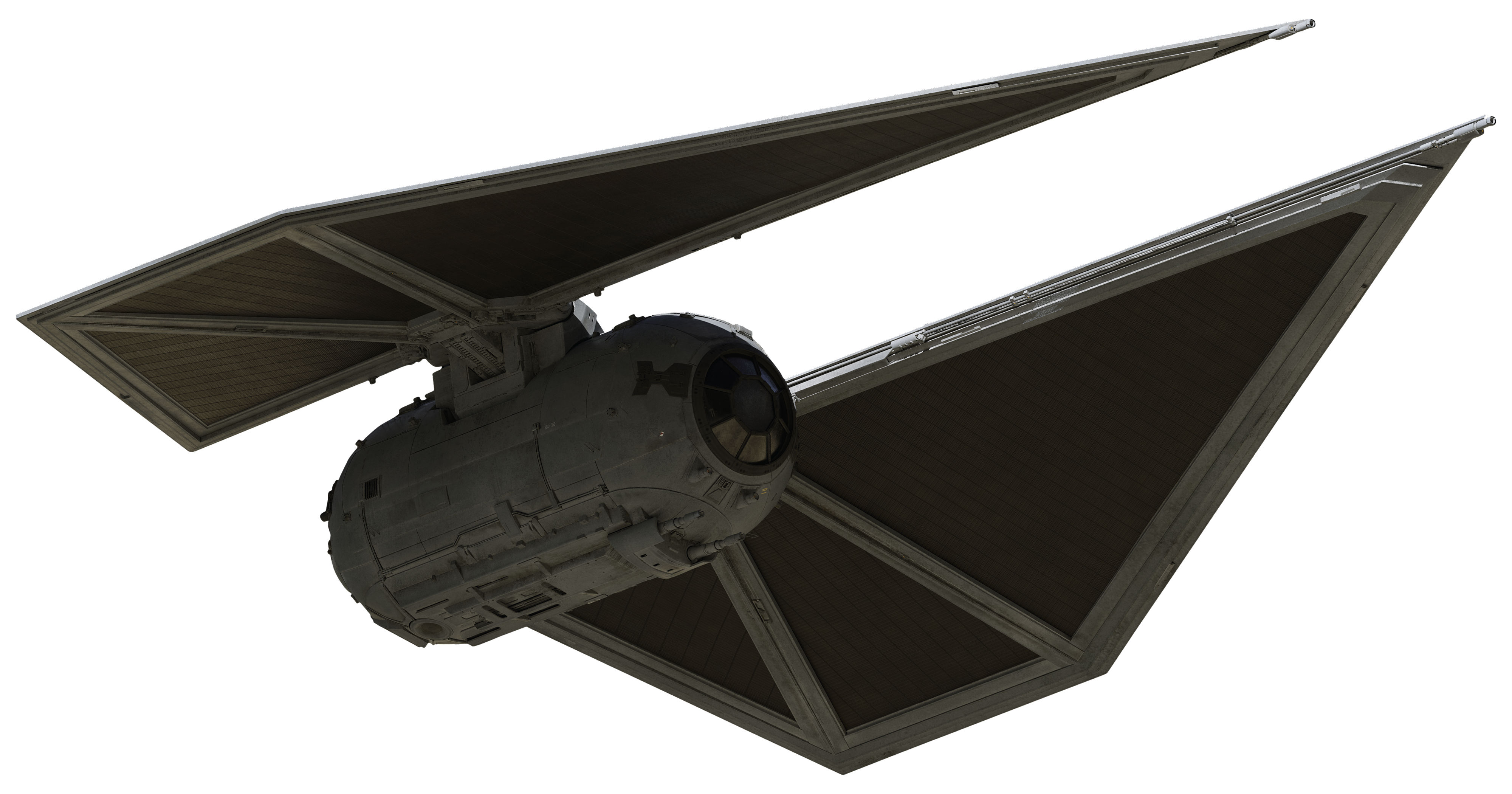
The TIE/sk x1 experimental air superiority fighter was an atmospheric fighter that was capable of starfighter operations.
For atmospheric flight and during landings and takeoffs, starfighters carried repulsorlift engines as a secondary means of propulsion. Because sublight engines' exhaust was hot and mildly radioactive, using them while inside an inhabited world's atmosphere was generally illegal. When the need was dire though a starfighter could use their sublight engines for extra speed during atmospheric flight, even flying at maximum acceleration as during the attack on Pandem Nai. While starfighters could function in an atmosphere at such speeds, it put tremendous strain on the ships and the pilots themselves. Systems would start to fail after just several minutes of such velocities, and laser cannons were at risk of melting from the heat generated by these maneuvers. Starfighters equipped with deflector shields could use them help smooth their passage through and allow for greater control when operating in an atmosphere. Deflector shields could also allow starfighters like the ARC-170 and V-wing to achieve hypersonic velocities in an atmosphere.
However, most starfighters were not built to excel at atmospheric flight, and were at a disadvantage against airspeeders when flying below mountain range as they were forced to sacrifice their superior speed. Exceptions to this included the X-wing and TIE/sk x1 experimental air superiority fighter, the latter of which was classified as an atmospheric fighter, yet it also functioned as a starfighter.
Starfighters had been an integral part of space-based combat for millennia, seeing action as early as the days of the Old Republic. However, with the formation of the modern Galactic Republic and the millennium of relative peace that followed, large-scale battles between opposing space-based combatants were completely unheard of.
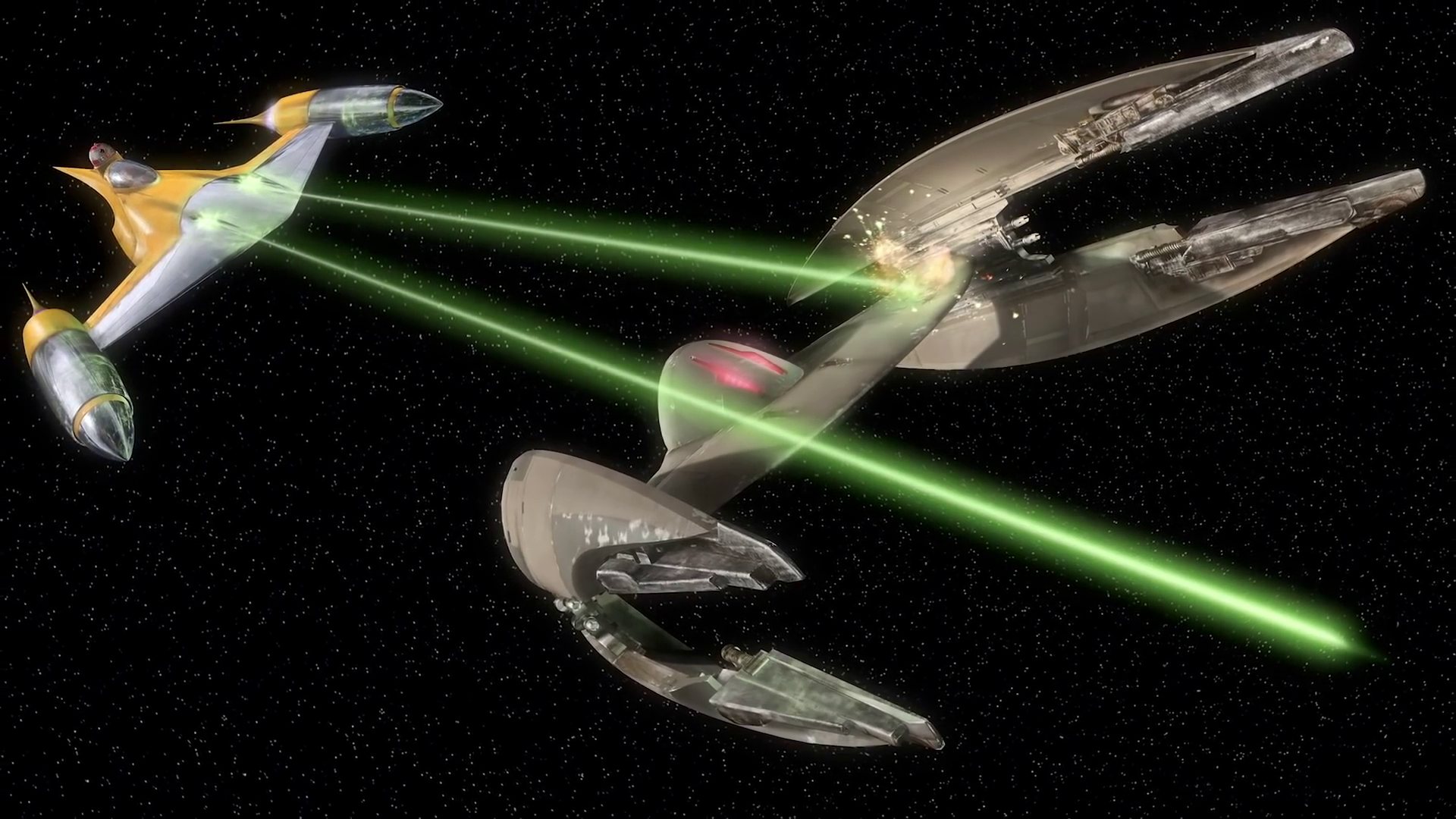
An N-1 starfighter firing on a Vulture droid.
In 32 BBY, the Jedi Order operated the Delta-7 Aethersprite-class light interceptor, but primarily used them for personal transport instead of space combat.
That year, N-1 starfighters of the Naboo Royal Space Fighter Corps engaged and defeated the Trade Federation's Vulture-class starfighters during the latter's invasion of Naboo. A number of N-1s remained combat capable all the way through the end of the Cold War. The Vulture droids also had a long lifespan, with some remaining operational in the Age of the Empire.
Also around that time, Darth Maul operated the Scimitar, a customized Star Courier that was also a formidable starfighter. It remained in service of the Sith Order well into the Imperial era.
Towards the end of the Separatist Crisis, Jango Fett owned and operated Slave I, a customized Firespray-31-class patrol and attack craft. After his death at the First Battle of Geonosis, his son Boba took possession of the ship and continued using it until at least 9 ABY.
During the Clone Wars, the Jedi continued utilizing the old Delta-7s, but also developed the Delta-7B Aethersprite-class light interceptor and Eta-2 Actis-class light interceptor. The clone trooper pilots under their command flew Low Altitude Assault Transport/infantry gunships, V-19 Torrent starfighters, BTL Y-wing starfighters, Aggressive ReConnaissance-170 starfighters, Clone Z-95 Headhunters, and Alpha-3 Nimbus-class V-wing starfighters. Grand Master Yoda operated his own customized Actis-class fighter. Skull Squadron, a Mandalorian unit serving the Republic, flew Fang fighters. At the conclusion of the Clone War, some of the Republic starfighter classes would be inherited by the Galactic Empire, while others would be decommissioned and fall into the hands of the rebellion. Others would be discarded entirely, seeing almost no military service after the conclusion of the war.
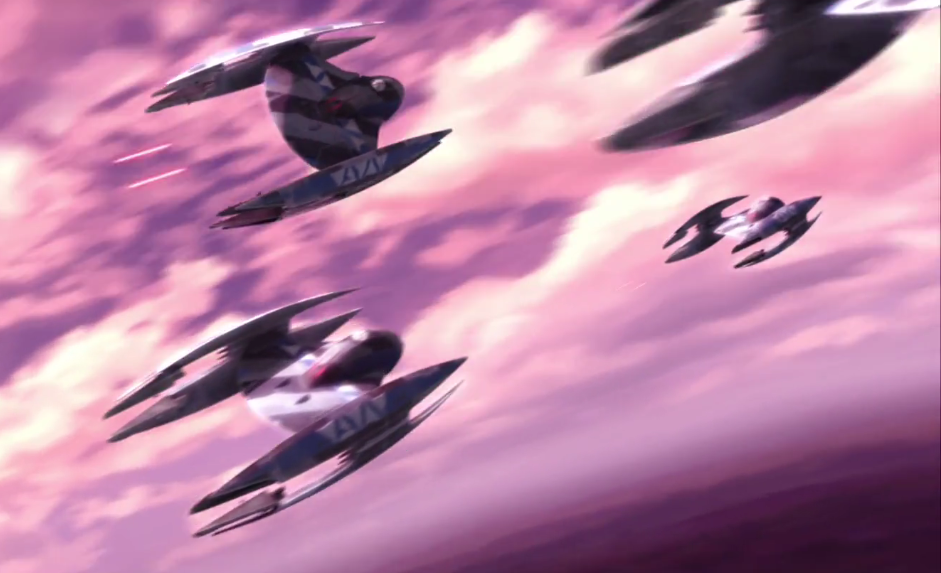
Vulture droids were major starfighters operated by the Confederacy.
The Separatists, which opposed the Republic in the Clone War, mainly used Vulture-class droid starfighters built for the Trade Federation. Later, to counter increasingly capable and diverse clone fighters, the Confederacy manufactured and deployed droid tri-fighters, Hyena-class Droid Bombers, and HMP droid gunships. The Separatists also built manned fighters for their organic commanders, such as Rogue-class Porax-38 starfighters, Belbullab-22 heavy starfighters, and Ginivex-class fanblade starfighter. Geonosian forces, which allied themselves with the Confederacy, flew Nantex-class territorial defense starfighters, while the Umbaran Militia flew their indigenous Zenuas 33 Umbaran starfighters. The Zygerrian Slave Empire, which allied itself with the Confederacy, had a small force of Huttese HH-87 Starhoppers, which saw action against Republic forces on Kadavo. Death Watch, a Mandalorian splinter group allied to the Confederacy, operated Kom'rk-class fighter/transports, which doubled as transports and bombers. After falling out of Count Dooku's favor, Death Watch would pledge their loyalty to Darth Maul's Shadow Collective, but would continue to use the ships in battle. After the conclusion of the war, many of the starfighters used by the Confederacy's regular forces survived the Clone War and were used by rebels fighting against the Empire.
At the conclusion of the Clone War, the Imperial Military inherited some of the starfighter classes of the Republic Navy. By the time of the Galactic Civil War, however, it was reliant on the TIE fighter series. This new generation of vehicles, powered by twin ion engines, were developed from technology used in the older Republic starfighter and transport classes. These craft included the famous TIE/ln space superiority starfighter, TIE/rb heavy starfighter, TIE Advanced v1, TIE/sa bomber, TIE Advanced x1, TIE/IN interceptor, TIE/d "Defender" Multi-Role Starfighter, TIE/sk x1 experimental air superiority fighter, and TIE/rp Reaper attack lander. The Empire also deployed VT-49 Decimators and Y-45 armored transport haulers. In addition to Imperial use, numerous TIE/LNs were given to the Mining Guild and converted to TIE/mg Mining Guild starfighters. Imperial TIEs would occasionally fall into rebel hands, and the rebellion made good use of these opportunities.
Out of desperation for any equipment they could obtain, the rebellion operated numerous starfighter classes from a variety of sources. Bail Organa's rebel network operated RZ-1 A-wing interceptors as early as 18 BBY. The Free Ryloth Movement used old Separatist droid starfighters in 14 BBY. Berch Teller's rebel cell also used Separatist fighters, in addition to Z-95 Headhunters. Beginning around 5 BBY,the Spectres made use of the Phantom, a customized Corellian VCX-series auxiliary starfighter that doubled as a shuttle and scout craft. The Spectres eventually joined Phoenix Cell, which utilized A-wings and a small number of RZ-1T trainers, which were A-wings converted into two-seat trainers. Jan Dodonna's unit made use of decommissioned Republic Y-wings, which served as multi-role fighter-bombers. Later, the loose-knit network of rebel cells morphed into the better-organized Alliance to Restore the Republic, which continued to operate a fairly ragtag collection of whatever equipment they could acquire.
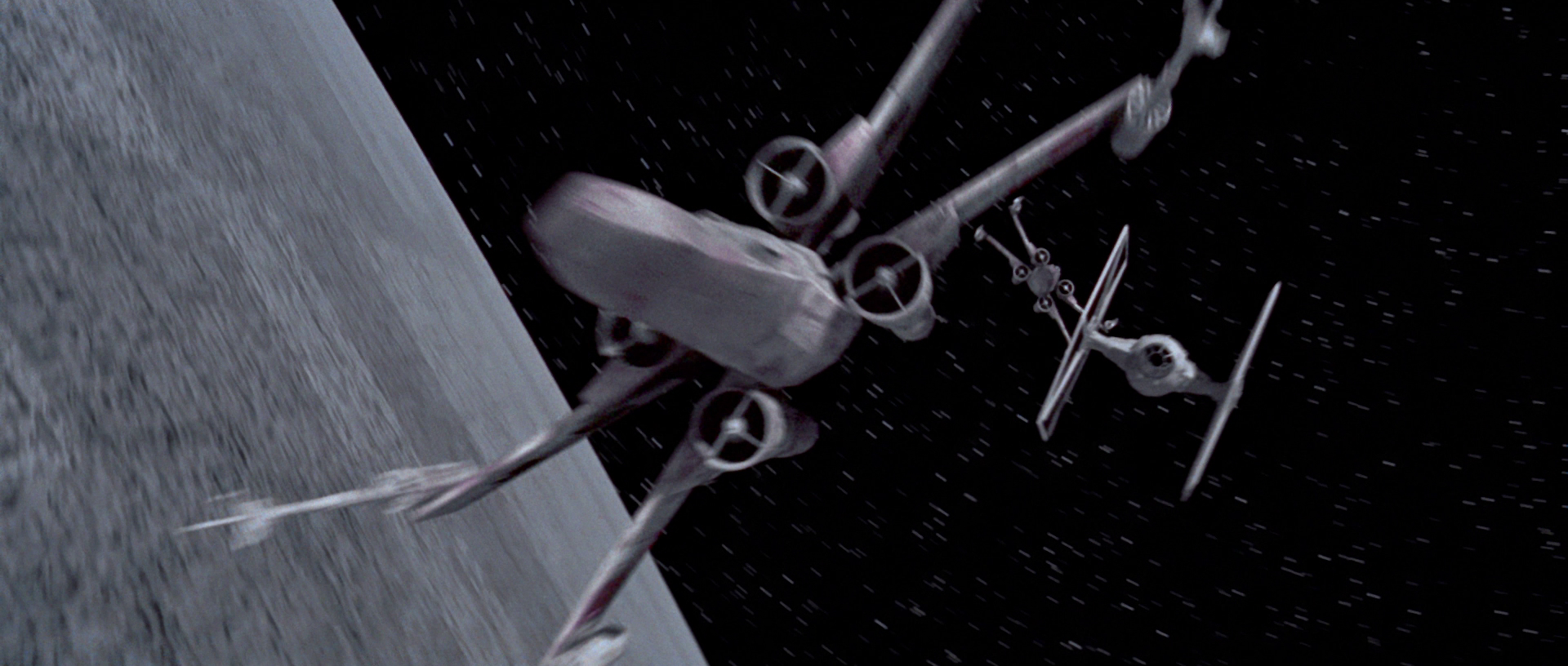
TIEs and X-wings became symbols of the Empire and Rebellion.
The Rebel Alliance Starfighter Corps made use of A/SF-01 B-wing starfighters, E-50 Landseers, converted HWK-290 light freighters, T-47 airspeeders, T-65B X-wing starfighters, T-65C-A2 X-wing starfighters, UT-60D U-wing starfighter/support craft, V-4X-D ski speeders, and at least one YT-1300 light freighter, in addition to some of the older classes. Additionally, the rebellion made use of stolen Imperial vessels. Many starfighter types used by the various rebel groups continued to see action with the New Republic.
A number of starfighter classes were used by private security forces, such as the Storm IV Twin-Pod cloud cars used by the Bespin Wing Guard.
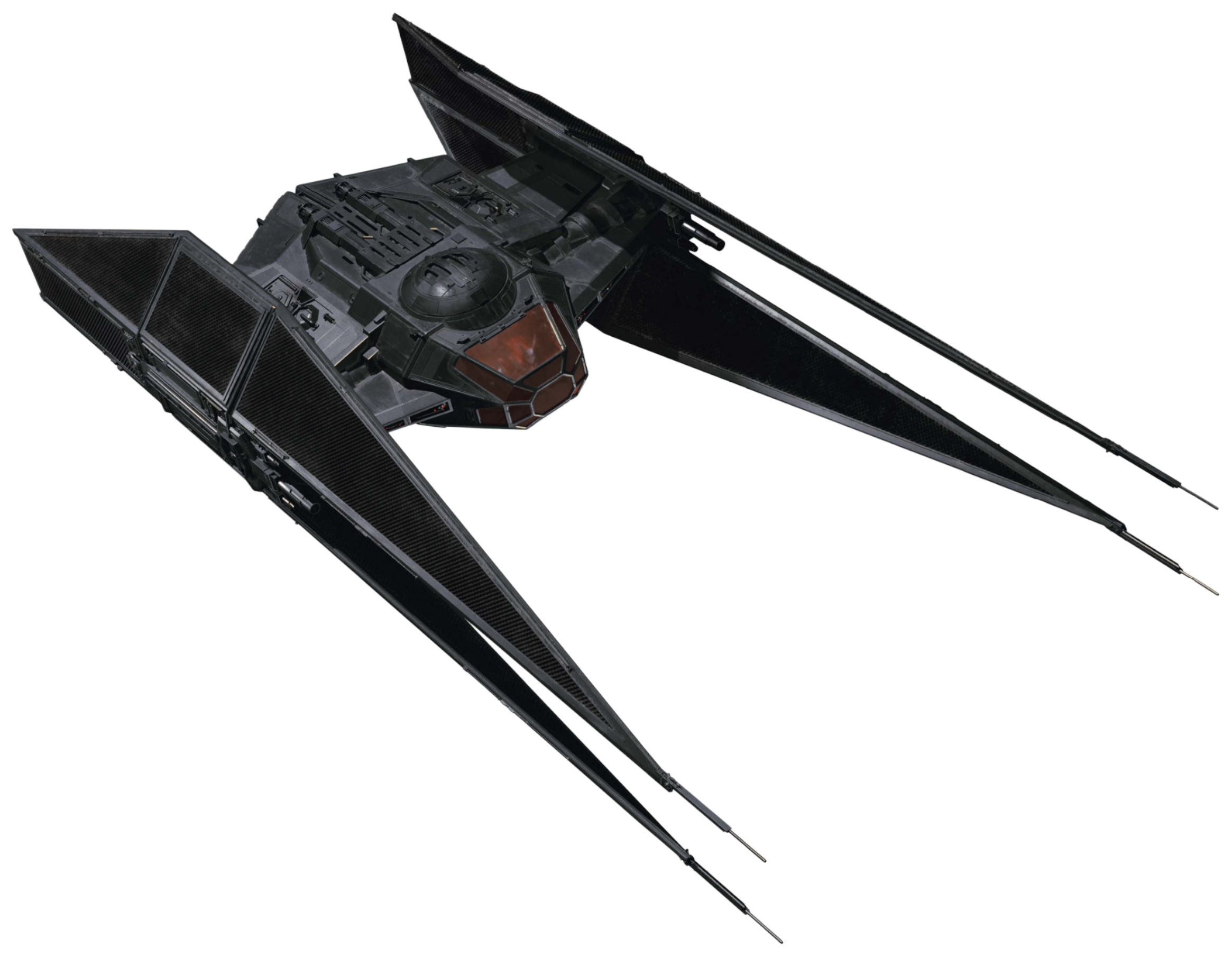
The TIE silencer was considered the ultimate evolution of the TIE design.
In its early days, the New Republic continued to operate the rebellion's old starfighter classes, and even continued stealing TIEs when the need arose. Beginning in 5 ABY, the New Republic operated the T-70 X-wing starfighter, which was an upgraded version of the T-65. They also operated RZ-2 A-wing interceptors. By the time of the cold war, the New Republic Defense Fleet had retired all of the older starfighter classes (as well as some of the newer ones, such as the B-wing Mark II) in favor of the T-85 X-wing.
The Resistance's Starfighter Corps continued using T-70s donated by sympathetic senators. They also made use of a small number of single-seat A-wings and a few Z-95 Headhunters for covert operations. On occasion, Resistance personnel would steal First Order TIEs, just like their Rebel predecessors had 30 years before.
The First Order Navy continued the TIE line that the Empire had begun, with the new models upgraded to modern combat standards. This new generation of TIEs included the TIE/fo space superiority fighter, the two-seat TIE/sf space superiority fighter used by the First Order Special Forces, and the TIE/vn space superiority fighter used by Kylo Ren.
- Star Wars: Visions — "T0-B1"
- Star Wars: Visions — "Lop & Ochō"
- Star Wars: Visions — "I Am Your Mother"
- LEGO STAR WARS: Celebrate the Season — "All I Want For Life Day"
- Rogue One: Recon A Star Wars 360 Experience
- Star Wars Epic Yarns: A New Hope
- LEGO Star Wars: Droid Tales Episodes I-III
- LEGO STAR WARS: Celebrate the Season — "Gifting With Grogu"
- Star Wars Resistance Racer
- LEGO Star Wars: The Force Awakens
- LEGO Star Wars: The Skywalker Saga
- Star Wars: Puzzle Droids
- LEGO STAR WARS: Celebrate the Season — "Sithmas Battle"
- "The Dragonsnake Saves R2-D2" — From a Certain Point of View: The Empire Strikes Back
- LEGO Star Wars: Build Your Own Adventure
- The Art of Star Wars: Visions